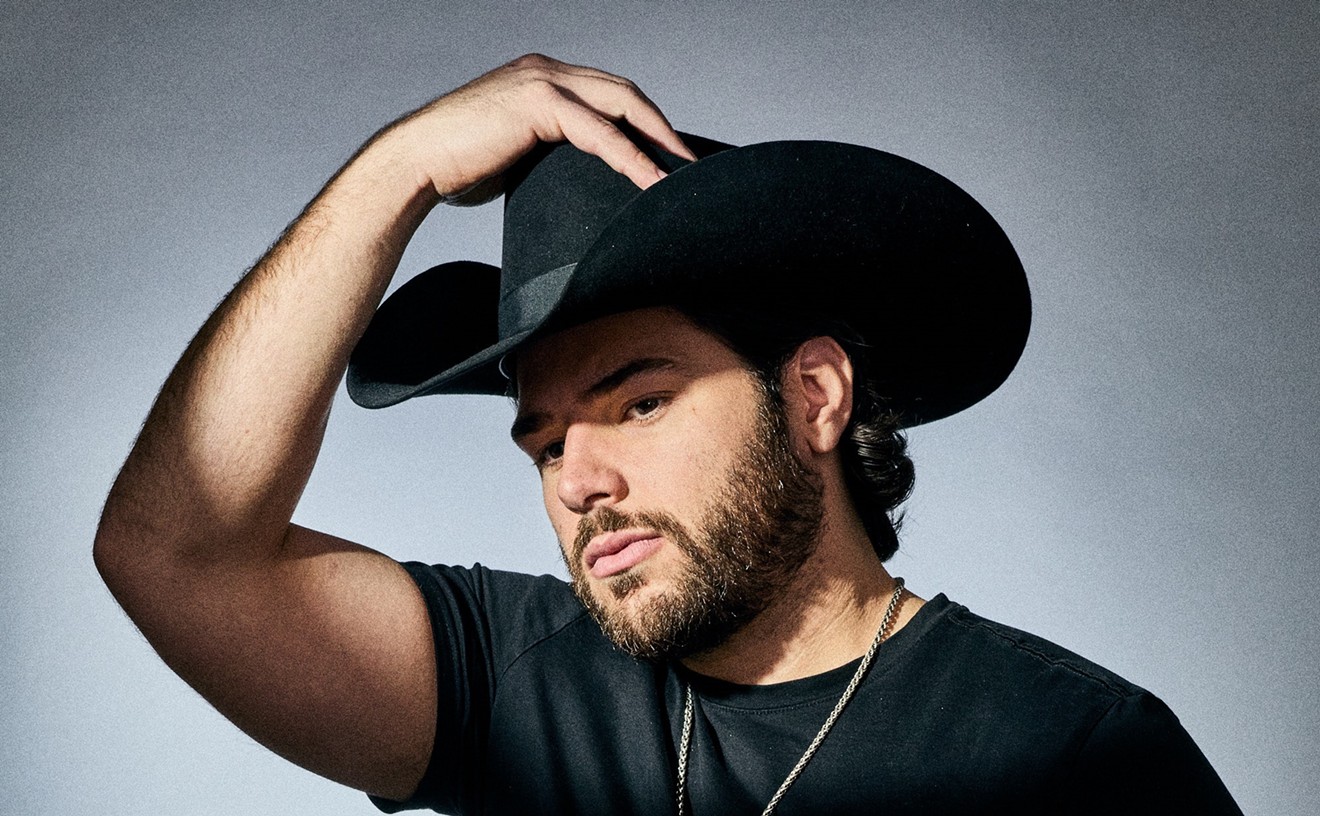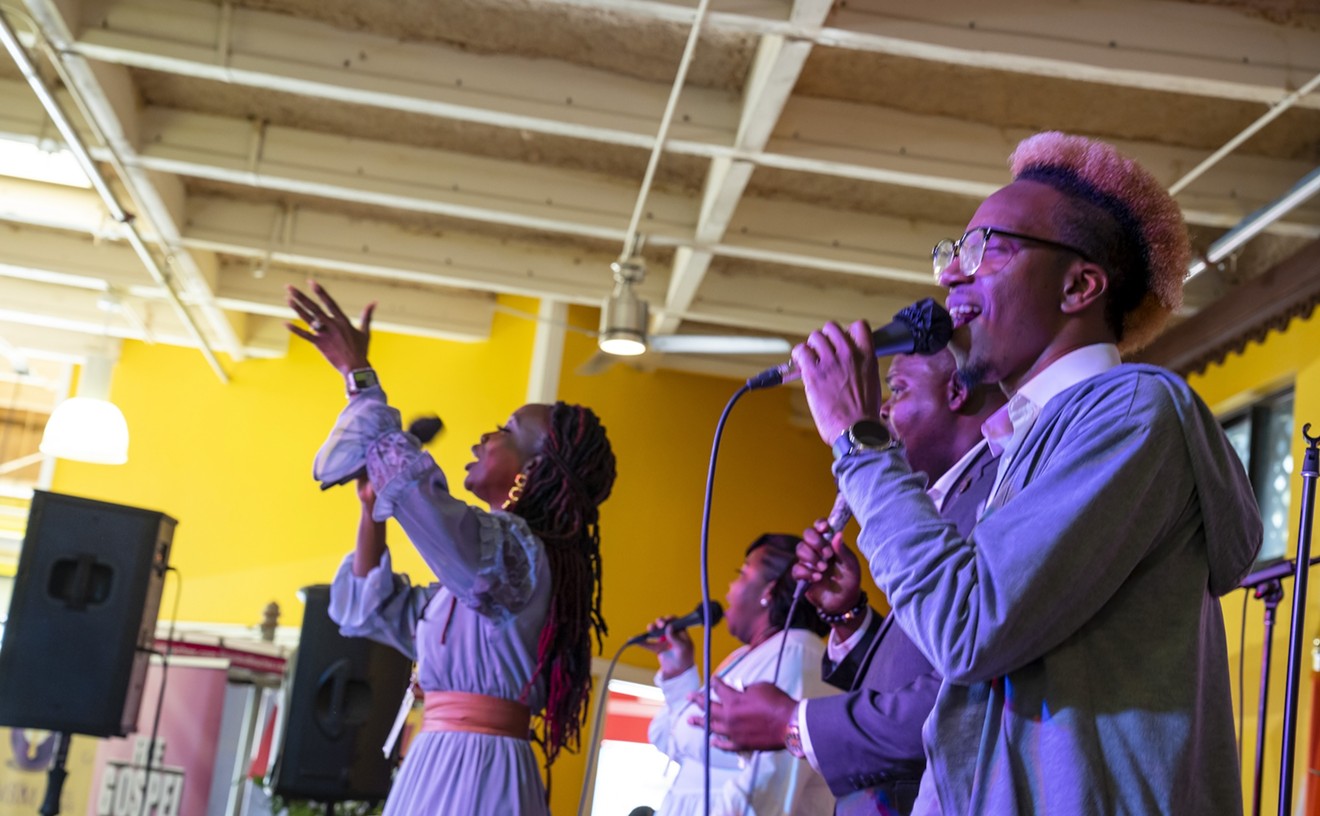But Larry Blackmon is not doing an interview, nor is he plugging a new album. After all, Cameo, the group he has led since the early Seventies, hasn't had a major hit since 1986's "Word Up." So what's he doing on the radio?
Blackmon -- drummer, bassist, songwriter, choreographer, producer, and director, famous for his trademark expression "Ow!" and his Gumby-esque fade hairdo as well as for his outrageous on-stage attire, which often included football player-size shoulder pads and a fire-engine red codpiece -- is now a disc jockey. He's been the voice of HOT 105's Saturday night Metro Funk Shop since January.
Blackmon was invited to join the 105 crew after sitting in as a guest on the Funk Shop, which was then hosted by assistant program director Phil Michaels (a fill-in for the show's original host Stonewall Jackson, who left the station to pursue other opportunities). Witty, charming, and possessing a mellifluous and radio-ready voice, Blackmon was an on-air natural; a job offer soon followed. "We knew he lived here now, and I was very excited to have someone of his caliber and with his knowledge of music involved in our station," says Tony Kidd, operations manager at HOT 105, the city's number-one-ranked station in the urban/adult contemporary category and number three in the South Florida market overall, according to an Arbitron survey. "It's been great so far. Before, it was purely a music show, but now we're trying to take it in a different direction, from being just a music show to being a real entertainment feature. We wanted to add some personality to it."
Anyone who's familiar with Cameo's string of hits knows Blackmon has plenty of personality. Ironically, the guy's not really a radio fan. "I don't listen to much radio," he confesses. "Not music. I listen to talk radio and sports radio because that's the only time I can get in touch with what's going on in the world. I live in music every day, so when I get in the car the last thing I do is turn on a music station." Nevertheless, Blackmon took the gig: "I thought it would be a gas, and it's been wonderful. I'm having a real good time. I don't know if I was as interested in radio as I was in just having fun. They told me I could do anything I wanted, so I came up with the idea of trying to syndicate the show. Hopefully by the fall we'll be syndicated."
For now, the three-hour show is in search of a distinct image. The playlist of Seventies and early Eighties funk hits is arranged by Michaels, with Blackmon offering segue and programming tips. (At one point during a recent show, Blackmon asks Michaels, "How does this song test?" as he suggests that the Tom Tom Club's "Genius of Love" be the opener for a twenty-minute set and the Ohio Players' "Love Rollercoaster" be dropped altogether.)
Interspersed between the music are a few recorded and live improvisational comic bits -- what the crew likes to call "funk on the fly" -- starring a cast of six or seven characters portrayed by Blackmon's colleagues. (On one night an Indian man threatens to blow up the station with his newly acquired bomb, then two Italian goodfellas -- Tony Two Fingers and Johnny Ravioli -- inform the host that funk music has an Italian as well as black audience.) The show is rounded out with occasional interviews with well-known funksters, a pre-recorded segment called "Stories from Backstage" featuring show-biz anecdotes from Blackmon's life, and phone calls from listeners -- some live, some taped, some bogus -- which generate amusing and lively banter.
In the middle of this night's show, for instance, a fictitious listener named Angie calls to ask if whatever was behind the red cup Blackmon wore during his Cameo days was "real," generating guffaws from Blackmon. Whatever the case, the self-described "codpiece wearin', sometimes swearin'" DJ chose to leave that accessory at home. Blackmon is conservatively dressed in green and beige plaid cotton shorts. The scowling visage of Miles Davis peers from the front of his white T-shirt, and ankle-length white athletic socks creep from the tops of his pristine leather Converse sneakers. The famous fade has been replaced with short dreadlocks, and a close-cropped mustache droops down past the corners of his mouth. His heavy-lidded eyes are shielded behind rectangular black-rimmed sunglasses with red lenses.
It's a far cry from the outlandish silks and leathers once worn by Cameo, the thirteen-piece group Blackmon formed in 1974 as the generically titled New York City Players. Born and raised in the Big Apple, Blackmon was a regular at Harlem's famed Apollo Theater, where he would catch performances by R&B titans such as Otis Redding and funk avatar George Clinton. He formed his first bands during junior high, and in his early twenties attended the Juilliard School of Music while fronting the Players, who were mining the polyrhythmic pop-funk-rock turf of Clinton, the Ohio Players, and Earth, Wind and Fire. "I wanted to have an act that was professional and very different, a little left of center, with a real New York artsy attitude about it," Blackmon explains. "We would seek out costume designers who were particularly talented, we'd look for the young Roman Polanskis to direct our videos. We wanted the edgy people. We were doing things that other people didn't think about doing."
After a change of name to the more manageable Cameo, the group landed a record deal with Clinton's Chocolate City imprint and had a modest hit on the R&B chart with their 1977 debut single "Rigor Mortis." A slew of singles and albums followed, all in the same wiggy-funk vein, but in 1982 Cameo relocated to Atlanta and re-emerged two years later as a three-piece with a new label (Polygram's Atlanta Artists affiliate) and a number-one hit on Billboard's R&B chart ("She's Strange," also the group's first Top 50 pop hit).
In 1986 Blackmon wrote the song that would become Cameo's signature -- "Word Up," a huge crossover success built around a drawling Blackmon vocal, relentless synth riffs, and a serpentine melody borrowed from Ennio Morricone's "The Good, the Bad, and the Ugly." The album of the same name yielded a second hit, "Candy," but burnout from a rigorous touring schedule set in, and as rap began to dominate the R&B charts, Cameo's driving pop-funk fusions became passe. Although the group continued to record, a three- year hiatus from the road gave Blackmon time to freelance as a producer for Miles Davis, Eddie Murphy, and Bobby Brown, and in 1992 he was recruited to work as an A&R rep for Warner Bros. He quit two years later and set up the Way 2 Funky label for Cameo's 1994 release In the Face of Funk, a solid but unsuccessful effort.
"The problem with having hit records is when you make a new one people always ask, 'Will it sound like what you did [in the past]?'" says Blackmon, who is juggling his duties at HOT 105 with studio work on a new Cameo album to be released this fall. "But if you look at Cameo's history, we have always had an eclectic nature and the songs were always different, from reggae to ballads to other things. I'm not trying to make a record for today's music market. I'm trying to make a record for tomorrow's music market, and that's how Cameo's always been -- progressive musically. Today's real big artists give in to the popular sound of today. It just sounds as if they're making records to fit in with what they think is going on today. There was a time when Michael [Jackson] would release a record that would take us somewhere else and you'd think: 'Wow, that's really nice and new.' And then everyone starts to cave. I am not going to cave."
Nor is he looking to return to his hectic schedule of the mid-Eighties. He's working at his own pace, looking for success on his own terms. "Things have slowed down a great deal, and that's good," Blackmon states. "You can see all the imperfections, even in your personal life, that you can attend to and you can have a little peace. If I were as successful as I'd like to be, I wouldn't be able to go much of anyplace or do anything. So I'm enjoying this time, preparing myself for where I want to be. And if I can make a living doing what I'm doing and having fun, everything else will take care of itself.










